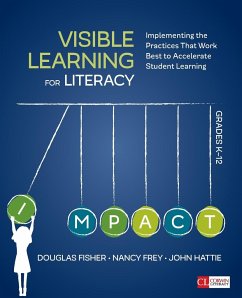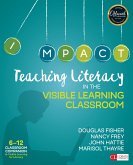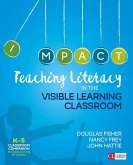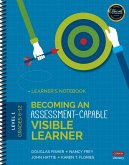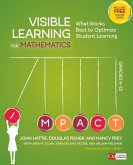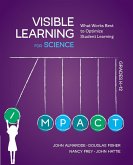Douglas Fisher, Nancy Frey, John Hattie
Visible Learning for Literacy, Grades K-12
Implementing the Practices That Work Best to Accelerate Student Learning
Douglas Fisher, Nancy Frey, John Hattie
Visible Learning for Literacy, Grades K-12
Implementing the Practices That Work Best to Accelerate Student Learning
- Broschiertes Buch
- Merkliste
- Auf die Merkliste
- Bewerten Bewerten
- Teilen
- Produkt teilen
- Produkterinnerung
- Produkterinnerung
Renowned literacy experts Douglas Fisher and Nancy Frey work with John Hattie to apply his groundbreaking research to literacy practices.
Andere Kunden interessierten sich auch für
![Teaching Literacy in the Visible Learning Classroom, Grades 6-12 Teaching Literacy in the Visible Learning Classroom, Grades 6-12]() Douglas FisherTeaching Literacy in the Visible Learning Classroom, Grades 6-1248,99 €
Douglas FisherTeaching Literacy in the Visible Learning Classroom, Grades 6-1248,99 €![Teaching Literacy in the Visible Learning Classroom, Grades K-5 Teaching Literacy in the Visible Learning Classroom, Grades K-5]() Douglas FisherTeaching Literacy in the Visible Learning Classroom, Grades K-538,99 €
Douglas FisherTeaching Literacy in the Visible Learning Classroom, Grades K-538,99 €![Becoming an Assessment-Capable Visible Learner, Grades 6-12, Level 1: Learner′s Notebook Becoming an Assessment-Capable Visible Learner, Grades 6-12, Level 1: Learner′s Notebook]() Douglas FisherBecoming an Assessment-Capable Visible Learner, Grades 6-12, Level 1: Learner′s Notebook16,99 €
Douglas FisherBecoming an Assessment-Capable Visible Learner, Grades 6-12, Level 1: Learner′s Notebook16,99 €![Visible Learning for Mathematics, Grades K-12 Visible Learning for Mathematics, Grades K-12]() John HattieVisible Learning for Mathematics, Grades K-1240,99 €
John HattieVisible Learning for Mathematics, Grades K-1240,99 €![Visible Learning for Science, Grades K-12 Visible Learning for Science, Grades K-12]() John T. AlmarodeVisible Learning for Science, Grades K-1240,99 €
John T. AlmarodeVisible Learning for Science, Grades K-1240,99 €![Text-Dependent Questions, Grades K-5 Text-Dependent Questions, Grades K-5]() Douglas FisherText-Dependent Questions, Grades K-538,99 €
Douglas FisherText-Dependent Questions, Grades K-538,99 €![The Big Book of Literacy Tasks, Grades K-8 The Big Book of Literacy Tasks, Grades K-8]() Nancy Akhavan (California State University, Fresno, USA)The Big Book of Literacy Tasks, Grades K-840,99 €
Nancy Akhavan (California State University, Fresno, USA)The Big Book of Literacy Tasks, Grades K-840,99 €-
-
-
Renowned literacy experts Douglas Fisher and Nancy Frey work with John Hattie to apply his groundbreaking research to literacy practices.
Hinweis: Dieser Artikel kann nur an eine deutsche Lieferadresse ausgeliefert werden.
Hinweis: Dieser Artikel kann nur an eine deutsche Lieferadresse ausgeliefert werden.
Produktdetails
- Produktdetails
- Corwin Literacy
- Verlag: SAGE Publications Inc
- Seitenzahl: 216
- Erscheinungstermin: 29. März 2016
- Englisch
- Abmessung: 235mm x 191mm x 12mm
- Gewicht: 442g
- ISBN-13: 9781506332352
- ISBN-10: 1506332358
- Artikelnr.: 44547737
- Herstellerkennzeichnung
- Libri GmbH
- Europaallee 1
- 36244 Bad Hersfeld
- gpsr@libri.de
- Corwin Literacy
- Verlag: SAGE Publications Inc
- Seitenzahl: 216
- Erscheinungstermin: 29. März 2016
- Englisch
- Abmessung: 235mm x 191mm x 12mm
- Gewicht: 442g
- ISBN-13: 9781506332352
- ISBN-10: 1506332358
- Artikelnr.: 44547737
- Herstellerkennzeichnung
- Libri GmbH
- Europaallee 1
- 36244 Bad Hersfeld
- gpsr@libri.de
Douglas Fisher is professor and chair of educational leadership at San Diego State University and a teacher leader at Health Sciences High and Middle College. Previously, Doug was an early intervention teacher and elementary school educator. He is a credentialed English teacher and administrator in California. In 2022, he was inducted into the Reading Hall of Fame by the Literacy Research Association. He has published numerous articles on reading and literacy, differentiated instruction, and curriculum design, as well as books such as The Teacher Clarity Playbook 2/e, Your Introduction to PLC+, The Illustrated Guide to Teacher Credibility, The Teaching Reading Playbook, and Welcome to Teaching!.
List of Videos
Preface
Acknowledgments
Chapter 1. Laying the Groundwork for Visible Learning for Literacy
The Evidence Base
Meta-Analyses
Effect Sizes
Noticing What Works
Learning From What Works, Not Limited to Literacy
Teacher Credibility
Teacher-Student Relationships
Teacher Expectations
General Literacy Learning Practices
1. Challenge
2. Self-Efficacy
3. Learning Intentions With Success Criteria
Conclusion
Chapter 2. Surface Literacy Learning
Why Surface Literacy Learning Is Essential
Acquisition and Consolidation
Acquisition of Literacy Learning Made Visible
Leveraging Prior Knowledge
Phonics Instruction and Direct Instruction in Context
Vocabulary Instruction
Mnemonics
Word Cards
Modeling Word Solving
Word and Concept Sorts
Wide Reading
Reading Comprehension Instruction in Context
Summarizing
Annotating Text
Note-Taking
Consolidation of Literacy Learning Made Visible
Rehearsal and Memorization Through Spaced Practice
Repeated Reading
Receiving Feedback
Collaborative Learning With Peers
Conclusion
Chapter 3. Deep Literacy Learning
Moving From Surface to Deep
Deep Acquisition and Deep Consolidation
Deep Acquisition of Literacy Learning Made Visible
Concept Mapping
Discussion and Questioning
Close Reading
Deep Consolidation of Literacy Learning Made Visible
Metacognitive Strategies
Reciprocal Teaching
Feedback to the Learner
Conclusion
Chapter 4. Teaching Literacy for Transfer
Moving From Deep Learning to Transfer
Types of Transfer: Near and Far
The Paths for Transfer: Low-Road Hugging and High-Road Bridging
Setting the Conditions for Transfer of Learning
Teaching Students to Organize Conceptual Knowledge
Students Identify Analogies
Peer Tutoring
Reading Across Documents
Problem-Solving Teaching
Teaching Students to Transform Conceptual Knowledge
Socratic Seminar
Extended Writing
Time to Investigate and Produce
Conclusion
Chapter 5. Determining Impact, Responding When the Impact Is Insufficient,
and Knowing What Does Not Work
Determining Impact
Preassessment
Postassessment
Responding When There Is Insufficient Impact
Response to Intervention
Screening
Quality Core Instruction
Progress Monitoring
Supplemental and Intensive Interventions
Learning From What Doesn't Work
Grade-Level Retention
Ability Grouping
Matching Learning Styles With Instruction
Test Prep
Homework
Conclusion
Appendix: Effect Sizes
References
Index
Preface
Acknowledgments
Chapter 1. Laying the Groundwork for Visible Learning for Literacy
The Evidence Base
Meta-Analyses
Effect Sizes
Noticing What Works
Learning From What Works, Not Limited to Literacy
Teacher Credibility
Teacher-Student Relationships
Teacher Expectations
General Literacy Learning Practices
1. Challenge
2. Self-Efficacy
3. Learning Intentions With Success Criteria
Conclusion
Chapter 2. Surface Literacy Learning
Why Surface Literacy Learning Is Essential
Acquisition and Consolidation
Acquisition of Literacy Learning Made Visible
Leveraging Prior Knowledge
Phonics Instruction and Direct Instruction in Context
Vocabulary Instruction
Mnemonics
Word Cards
Modeling Word Solving
Word and Concept Sorts
Wide Reading
Reading Comprehension Instruction in Context
Summarizing
Annotating Text
Note-Taking
Consolidation of Literacy Learning Made Visible
Rehearsal and Memorization Through Spaced Practice
Repeated Reading
Receiving Feedback
Collaborative Learning With Peers
Conclusion
Chapter 3. Deep Literacy Learning
Moving From Surface to Deep
Deep Acquisition and Deep Consolidation
Deep Acquisition of Literacy Learning Made Visible
Concept Mapping
Discussion and Questioning
Close Reading
Deep Consolidation of Literacy Learning Made Visible
Metacognitive Strategies
Reciprocal Teaching
Feedback to the Learner
Conclusion
Chapter 4. Teaching Literacy for Transfer
Moving From Deep Learning to Transfer
Types of Transfer: Near and Far
The Paths for Transfer: Low-Road Hugging and High-Road Bridging
Setting the Conditions for Transfer of Learning
Teaching Students to Organize Conceptual Knowledge
Students Identify Analogies
Peer Tutoring
Reading Across Documents
Problem-Solving Teaching
Teaching Students to Transform Conceptual Knowledge
Socratic Seminar
Extended Writing
Time to Investigate and Produce
Conclusion
Chapter 5. Determining Impact, Responding When the Impact Is Insufficient,
and Knowing What Does Not Work
Determining Impact
Preassessment
Postassessment
Responding When There Is Insufficient Impact
Response to Intervention
Screening
Quality Core Instruction
Progress Monitoring
Supplemental and Intensive Interventions
Learning From What Doesn't Work
Grade-Level Retention
Ability Grouping
Matching Learning Styles With Instruction
Test Prep
Homework
Conclusion
Appendix: Effect Sizes
References
Index
List of Videos
Preface
Acknowledgments
Chapter 1. Laying the Groundwork for Visible Learning for Literacy
The Evidence Base
Meta-Analyses
Effect Sizes
Noticing What Works
Learning From What Works, Not Limited to Literacy
Teacher Credibility
Teacher-Student Relationships
Teacher Expectations
General Literacy Learning Practices
1. Challenge
2. Self-Efficacy
3. Learning Intentions With Success Criteria
Conclusion
Chapter 2. Surface Literacy Learning
Why Surface Literacy Learning Is Essential
Acquisition and Consolidation
Acquisition of Literacy Learning Made Visible
Leveraging Prior Knowledge
Phonics Instruction and Direct Instruction in Context
Vocabulary Instruction
Mnemonics
Word Cards
Modeling Word Solving
Word and Concept Sorts
Wide Reading
Reading Comprehension Instruction in Context
Summarizing
Annotating Text
Note-Taking
Consolidation of Literacy Learning Made Visible
Rehearsal and Memorization Through Spaced Practice
Repeated Reading
Receiving Feedback
Collaborative Learning With Peers
Conclusion
Chapter 3. Deep Literacy Learning
Moving From Surface to Deep
Deep Acquisition and Deep Consolidation
Deep Acquisition of Literacy Learning Made Visible
Concept Mapping
Discussion and Questioning
Close Reading
Deep Consolidation of Literacy Learning Made Visible
Metacognitive Strategies
Reciprocal Teaching
Feedback to the Learner
Conclusion
Chapter 4. Teaching Literacy for Transfer
Moving From Deep Learning to Transfer
Types of Transfer: Near and Far
The Paths for Transfer: Low-Road Hugging and High-Road Bridging
Setting the Conditions for Transfer of Learning
Teaching Students to Organize Conceptual Knowledge
Students Identify Analogies
Peer Tutoring
Reading Across Documents
Problem-Solving Teaching
Teaching Students to Transform Conceptual Knowledge
Socratic Seminar
Extended Writing
Time to Investigate and Produce
Conclusion
Chapter 5. Determining Impact, Responding When the Impact Is Insufficient,
and Knowing What Does Not Work
Determining Impact
Preassessment
Postassessment
Responding When There Is Insufficient Impact
Response to Intervention
Screening
Quality Core Instruction
Progress Monitoring
Supplemental and Intensive Interventions
Learning From What Doesn't Work
Grade-Level Retention
Ability Grouping
Matching Learning Styles With Instruction
Test Prep
Homework
Conclusion
Appendix: Effect Sizes
References
Index
Preface
Acknowledgments
Chapter 1. Laying the Groundwork for Visible Learning for Literacy
The Evidence Base
Meta-Analyses
Effect Sizes
Noticing What Works
Learning From What Works, Not Limited to Literacy
Teacher Credibility
Teacher-Student Relationships
Teacher Expectations
General Literacy Learning Practices
1. Challenge
2. Self-Efficacy
3. Learning Intentions With Success Criteria
Conclusion
Chapter 2. Surface Literacy Learning
Why Surface Literacy Learning Is Essential
Acquisition and Consolidation
Acquisition of Literacy Learning Made Visible
Leveraging Prior Knowledge
Phonics Instruction and Direct Instruction in Context
Vocabulary Instruction
Mnemonics
Word Cards
Modeling Word Solving
Word and Concept Sorts
Wide Reading
Reading Comprehension Instruction in Context
Summarizing
Annotating Text
Note-Taking
Consolidation of Literacy Learning Made Visible
Rehearsal and Memorization Through Spaced Practice
Repeated Reading
Receiving Feedback
Collaborative Learning With Peers
Conclusion
Chapter 3. Deep Literacy Learning
Moving From Surface to Deep
Deep Acquisition and Deep Consolidation
Deep Acquisition of Literacy Learning Made Visible
Concept Mapping
Discussion and Questioning
Close Reading
Deep Consolidation of Literacy Learning Made Visible
Metacognitive Strategies
Reciprocal Teaching
Feedback to the Learner
Conclusion
Chapter 4. Teaching Literacy for Transfer
Moving From Deep Learning to Transfer
Types of Transfer: Near and Far
The Paths for Transfer: Low-Road Hugging and High-Road Bridging
Setting the Conditions for Transfer of Learning
Teaching Students to Organize Conceptual Knowledge
Students Identify Analogies
Peer Tutoring
Reading Across Documents
Problem-Solving Teaching
Teaching Students to Transform Conceptual Knowledge
Socratic Seminar
Extended Writing
Time to Investigate and Produce
Conclusion
Chapter 5. Determining Impact, Responding When the Impact Is Insufficient,
and Knowing What Does Not Work
Determining Impact
Preassessment
Postassessment
Responding When There Is Insufficient Impact
Response to Intervention
Screening
Quality Core Instruction
Progress Monitoring
Supplemental and Intensive Interventions
Learning From What Doesn't Work
Grade-Level Retention
Ability Grouping
Matching Learning Styles With Instruction
Test Prep
Homework
Conclusion
Appendix: Effect Sizes
References
Index

